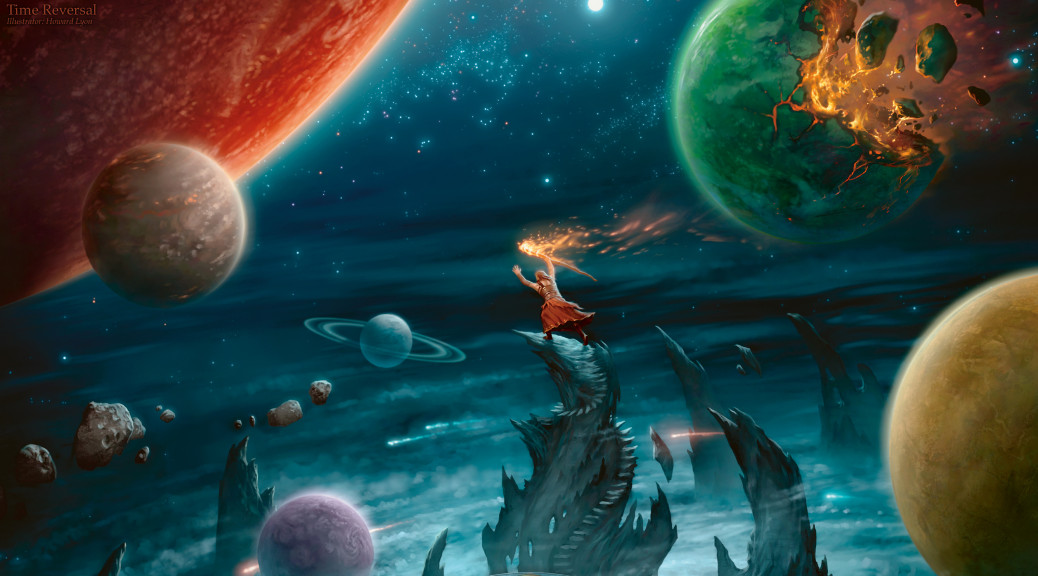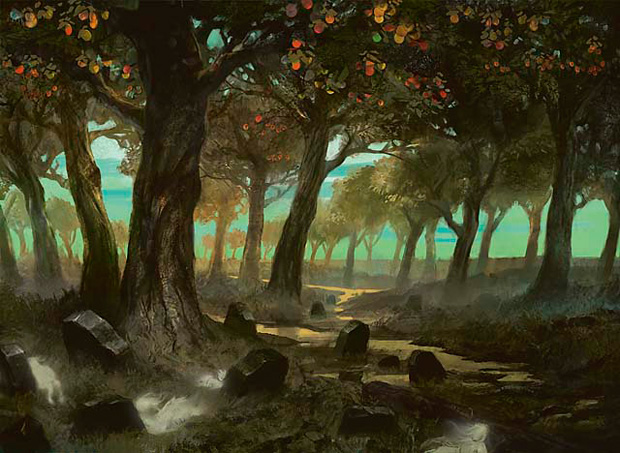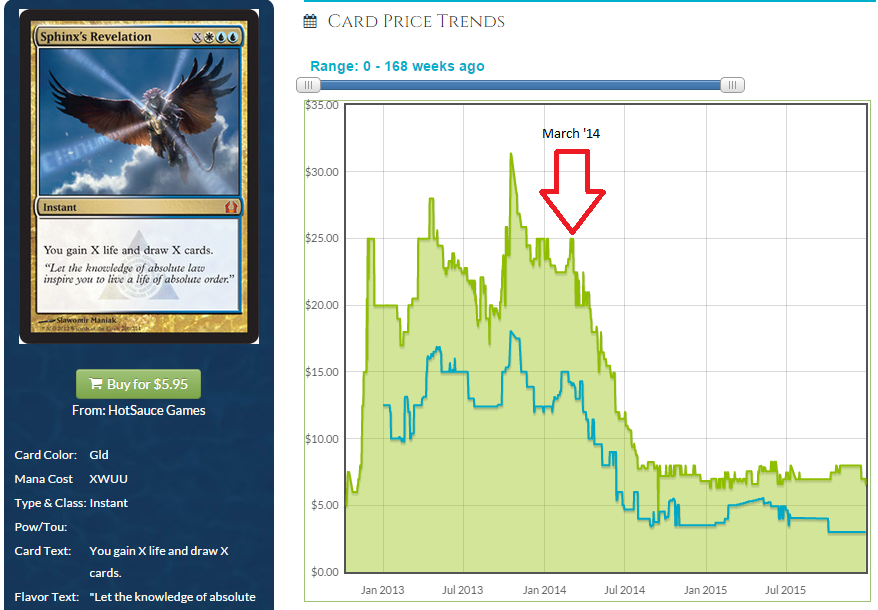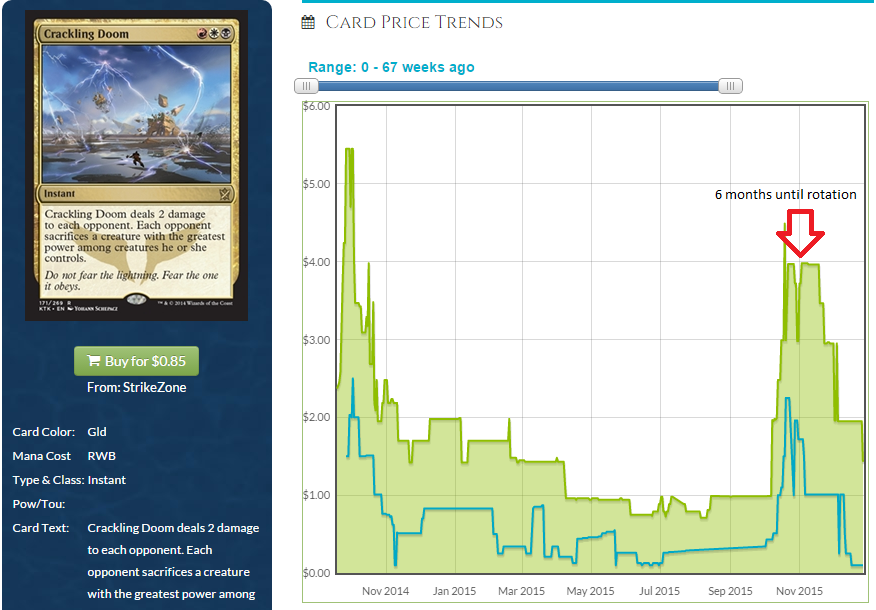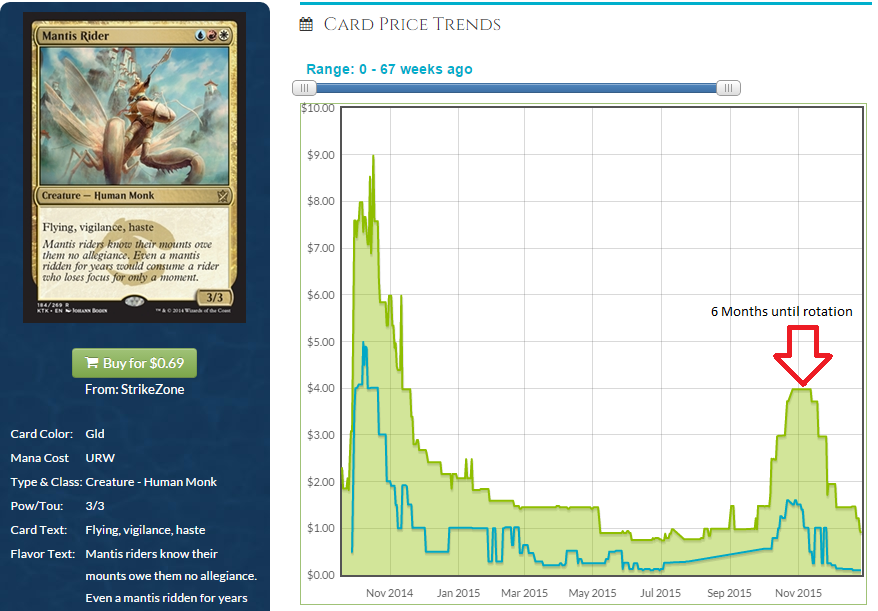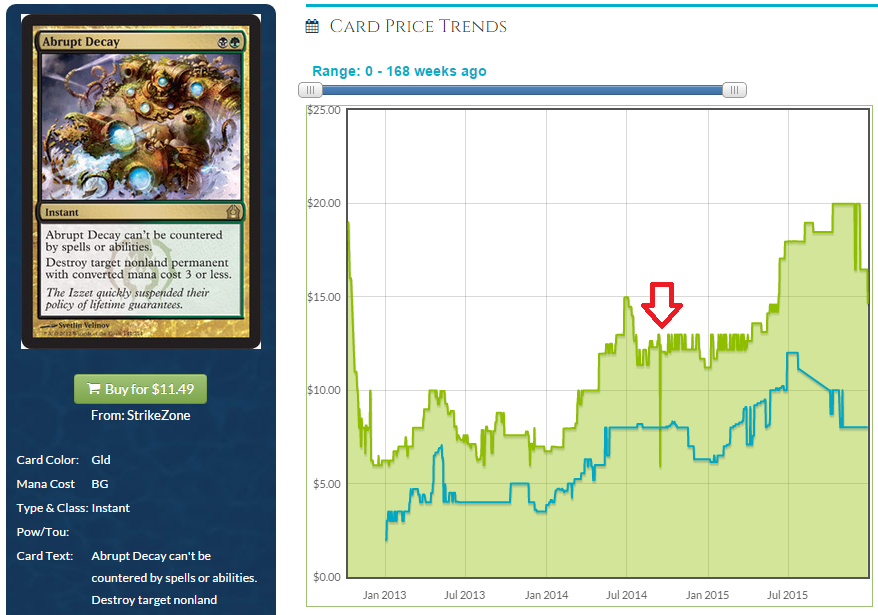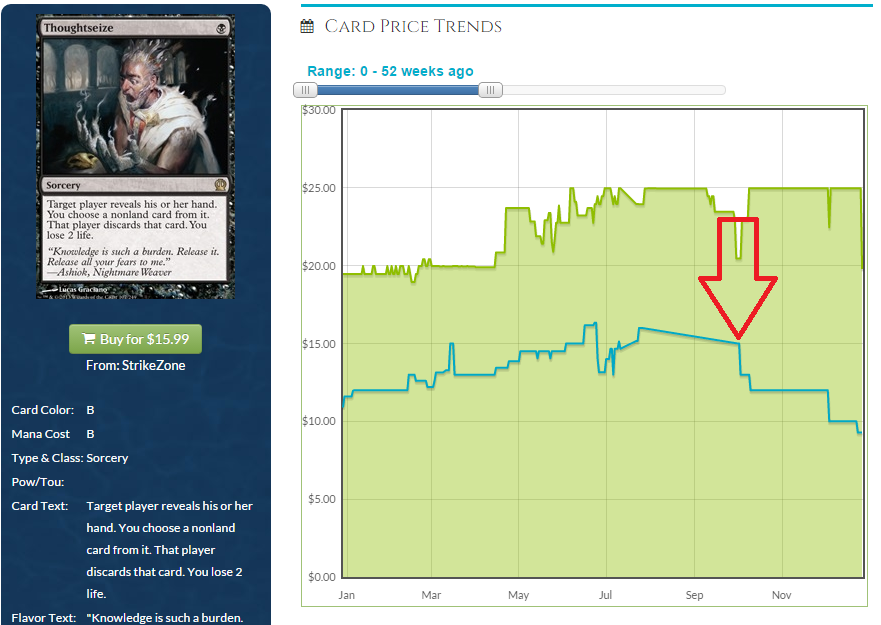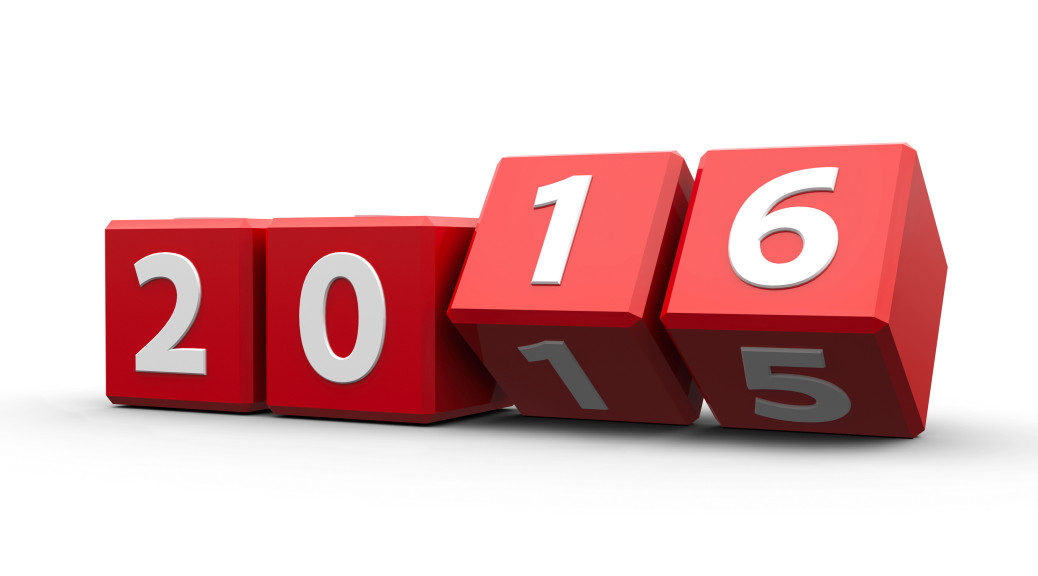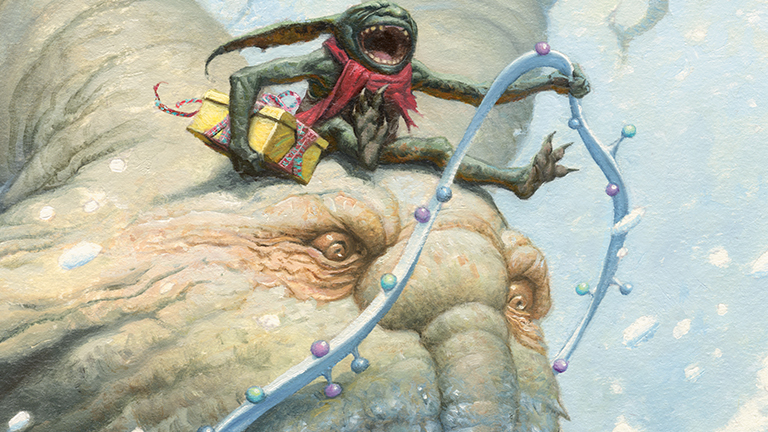By: Derek Madlem
No matter how you look at it, 2015 has been a big year for Magic. From a personal standpoint, 2015 has brought about the biggest changes for my personal connection to Magic in all of the years of playing. Seeing as it’s the end of the year and I’m not really interested in forcing an article about the rares featured in the Oath of the Gatewatch intro packs, how about a year in review? Glad you’re as excited as I am.
Khans of Tarkir
Yeah, technically this was released in 2014, but who are we kidding? Khans of Tarkir rang in the new year as the second coming of Christ and that momentum is carrying through to this day. From an #mtgfinance standpoint, Khans was very important lesson in aggregate pricing in modern Magic releases. When a single cycle of cards soaks up so much of the expected value from a box, the price of everything else collapses. Even Siege Rhino, one of the most powerful and most played creatures of all time, couldn’t maintain a price above $5 thanks to the fetch lands soaking up so much of the set’s value.
Fate Reforged
Fate Reforged was ultimately a gimmick set. It was a small set that was meant as a pivot point to be drafted with two separate large sets and is likely to be the first and last time we ever see that gimmick play out. The overall reception for Fate Reforged was not incredible despite having a decent concentration of powerful and expensive cards including Ugin, the Spirit Dragon, Tasigur, the Golden Fang, and Monastery Mentor. Even the bonus inclusion of a fetchland in every box wasn’t enough to keep this set from falling to the wayside in short order.
Vending
It wasn’t long after the release of Fate Reforged that I got my first shot working as an MTG buyer. Two Headed Games needed help for the SCG Regionals in Columbus and gave me a shot at helping out. Buying seemed to come naturally to me as I understood both the player and the business side of the transaction. I knew which cards players wanted and I knew how much the store had to buy them for to run a profitable business. At first I was meant to just be an extra set of hands, but a smoke break combined with a rush of players looking to sell cards put me in the buyer’s chair and my foray into MTG buying had begun.
MTGPrice and Dragons of Tarkir
Going back and looking for my first article published on MTGPrice, it seems fitting that my words first graced this website on April Fool’s Day…a coincidence that explains why nobody takes me seriously to this day. When the opportunity to write for MTGPrice presented itself, I was already writing for Quiet Speculation but was excited about the prospect of reaching a larger audience so I asked that none of my articles ever appear behind a paywall.
Meanwhile Dragons of Tarkir had just been released and I made some predictions that turned out to be mostly bad. You can go back and take a look here if you need fodder for mocking. Dragons of Tarkir did something that previously hadn’t been accomplished in quite some time – made the spring set relevant to constructed. Dragons of Tarkir managed to strike a chord with the casual crowd while still giving the constructed format a good shakeup and in general did better than previous spring sets according to a number of retailers that I talked to at the time.
The Big Stage
In May I began working as a buyer for Aether Games and my big debut was at Grand Prix Atlantic City. I learned a very valuable lesson on this trip: traveling for Magic is a lot less glamorous when the destination is a complete dump. Atlantic City is a place that everyone should visit at least once, if only to learn that such a terrible place exists in the world.
The event itself was alright, nothing too exciting or too terrible outside of a fire alarm going off mere minutes before the doors were set to open. I can attest that the last thing you want to hear after carefully placing cards in a display case is “scoop them up, we have to leave”.
Modern Masters 2015
As spoilers for this set came to completion, it became clear that this set was stuffed to the brim with Modern’s most expensive cards and featured a number of rares that suffered extreme prices based mostly on casual demand and small print runs. With larger print runs (and higher MSRP) making this set available to everyone, we were able to see the effect of aggregate pricing in action; a number of rares that were previously worth $10+ were suddenly available under $2…call it the Creakwood Liege effect.
Ultimately anything that wasn’t reprinted saw a surge in price thanks in part to the #mtgfinance hive mind and the realization that a flood of cheap Mox Opals hitting the market meant that more people would need Inkmoth Nexus and Arcbound Ravager. While much of this felt like market manipulation, much of it was more likely do to cards being frozen in price leading up to a potential reprint…after all, no vendor wanted to be buying cards for more than they would be able to sell them for in just a few short weeks. Either way, we won’t be making that mistake again…right?
Grand Prix Vegas
Grand Prix Vegas was billed as the biggest Magic event of all time and it definitely delivered. I had attended the previous Modern Masters Grand Prix in Las Vegas, thanks to my wife using it as bait to get me to agree to a Vegas vacation, so I thought I had a decent idea of what to expect going into this event, but it exceeded all expectations and set the bar pretty high going forward.
This was my second event working with Aether Games and I had front row seats to one of the greatest lessons of all time in #mtgfinance. Aether decided they were going to pay extremely well on a few cards when the rest of the room had intended to capitalize on the perception that everything was going to be worth much less. One vendor making an informed stand slowed the plummeting prices of cards like Dark Confidant, Vendilion Clique, and Tarmogoyf. While these cards eventually dipped in price, it was much more gradual and a lot less brutal.
Magic Origins
“The best core set since Magic 2010” – everyone
“I’ll take a pack of Khans” – everyone
Magic Origins and Jace, Vryn’s Prodigy reminded us of an age old #mtgfinance proverb: if a card is printed in a set and nobody buys it, shouldn’t it be $80? We were reminded again by Magic Origins that good cards in unpopular sets will climb in price. We saw a similar thing happen with Nissa, Worldwaker and Chandra, Pyromaster in the previous core sets. The last core set–good riddance.
The Ending of Vending
It wasn’t too long after Magic Origins that I realized vending probably wasn’t for me. After trying my hand with a few different vendors I realized it’s really a young man’s game. While I’m far from old man status, the prospect of sharing beds, sleeping on floors, hours and hours crammed in cars, the time away from home, and eating nothing but garbage for every meal just wasn’t worth the pay. Overall it was a good experience and I learned a lot in a very short amount of time; some of which you can (re)read here, easily one of the most (only) useful articles I’ve ever written.
SCG, PTQ, & Grand Prix Changes
This year also brought us a number of changes to PTQs and Grand Prix level events. PTQs as we knew them are wiped off the face of the Earth and with them so is low level vending. Grand Prixs are more expensive than ever for both players and vendors. Oh yeah, don’t forget that Star City Games killed Legacy–again. The sheer number of tournament changes this year has left the player base a little dizzy and many are still trying to figure out what the best path going forward is.
Battle for Zendikar
We learned with much certainty that lightning doesn’t strike twice in the same place. Battle for Zendikar is just the latest installment of increasingly worse “return to ______” expansions that somehow continue to get worse and worse with each iteration. The set would have probably been a total loss if not for the inclusion of randomly inserted 2/3rd art promo versions of the shock and fetch lands. The mediocre feel of Battle for Zendikar does little to make us excited for a return to Innistrad this spring, but there’s still hope…right?
Ultimately the roll out of BFZ was pretty rough, it did little to shake up Standard, more or less causing the format to go into hibernation at the local level while players patiently pray that Oath of the Gatewatch will bring us the change we need to make Standard fresh again.
The expeditions were enough to break me as a collector of Magic. For the first time I had to look at a set of new cards and acknowledge that they were simply unattainable for me, something that really took the wind out of my sails going forward.
The Rise of Massdrop
I don’t know if you’ve heard this yet, but massdrop.com is the place to buy older boxes of Magic at ridiculously low prices. With boxes of sets like Return to Ravnica and Gatecrash selling for as low as $80, it’s pretty much a fool’s errand to speculate on sealed booster boxes going forward. While this is great news for drafters, it’s terrible news for the couple dozen sealed booster boxes I have tucked away in my vault.
But really this isn’t just about Massdrop, it’s the internetification of all things. Amazon is especially guilty of this, but we’re seeing it more and more – volume without margins. Why sell ten of something for $20 profit each when you can sell a hundred at $2 profit each? This race to the bottom has grown more and more prevalent across the singles market just as much as it has the sealed product market. We now live in a world where the price of things goes down drastically if you’re just willing to wait a couple weeks.
Spoilers
If you listened to Wizards’ employees, this was a goddamn Greek tragedy. Somebody somewhere leaked photos of some damaged Expeditions and spoiled the big surprise that wasn’t much of a surprise to anyone that had given the topic much thought. We were given a heavy handed guilt trip about the leak ruining their marketing plan and blah blah blah, but that wasn’t enough. Wizards took it a step further when they suspended a number of judges simply for failing to report that said leak existed. This scandal is far from over, but it really became the cherry on top of the turd sundae we’ve been munching on all year.
A New Job
The end of the year took an interesting twist in my personal life as well. I was offered a job managing a local game store seemingly out of no where. It’s an awesome opportunity to test my mettle at something I am passionate about. But the drawback is that I’m forced to test the words that I’ve been told time and time again: once you start running a game store, you lose all interest in playing. Time’s going to tell on this one.
May your 2016 be filled with Expeditions in your packs, power in your bulk, and no lands in your opponents’ starting hands.
